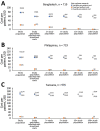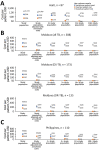Costs of Digital Adherence Technologies for Tuberculosis Treatment Support, 2018-2021
- PMID: 38146969
- PMCID: PMC10756355
- DOI: 10.3201/eid3001.230427
Costs of Digital Adherence Technologies for Tuberculosis Treatment Support, 2018-2021
Abstract
Digital adherence technologies are increasingly used to support tuberculosis (TB) treatment adherence. Using microcosting, we estimated healthcare system costs (in 2022 US dollars) of 2 digital adherence technologies, 99DOTS medication sleeves and video-observed therapy (VOT), implemented in demonstration projects during 2018-2021. We also obtained cost estimates for standard directly observed therapy (DOT). Estimated per-person costs of 99DOTS for drug-sensitive TB were $98 in Bangladesh (n = 719), $119 in the Philippines (n = 396), and $174 in Tanzania (n = 976). Estimated per-person costs of VOT were $1,154 in Haiti (87 drug-sensitive), $304 in Moldova (173 drug-sensitive), $452 in Moldova (135 drug-resistant), and $661 in the Philippines (110 drug-resistant). 99DOTS costs may be similar to or less expensive than standard DOT. VOT is more expensive, although in some settings, labor cost offsets or economies of scale may yield savings. 99DOTS and VOT may yield savings to local programs if donors cover infrastructure costs.
Keywords: Bangladesh; Haiti; Moldova; Tanzania; Tuberculosis; bacteria; cost; digital adherence technologies; pill sleeves; the Philippines; tuberculosis; tuberculosis and other mycobacteria; video-observed treatment.
Figures


References
-
- Stop TB; World Health Organization. An expanded DOTS framework for effective tuberculosis control. Int J Tuberc Lung Dis. 2002;6:378–88. - PubMed
-
- World Health Organization. What is DOTS? A guide to understanding the WHO-recommended TB control strategy known as DOTS [cited 2023 Mar 17]. https://apps.who.int/iris/handle/10665/65979
-
- World Health Organization. Guidelines for treatment of drug-susceptible tuberculosis and patient care [cited 2023 Mar 17]. https://apps.who.int/iris/bitstream/handle/10665/255052/9789241550000-en...
MeSH terms
LinkOut - more resources
Full Text Sources

